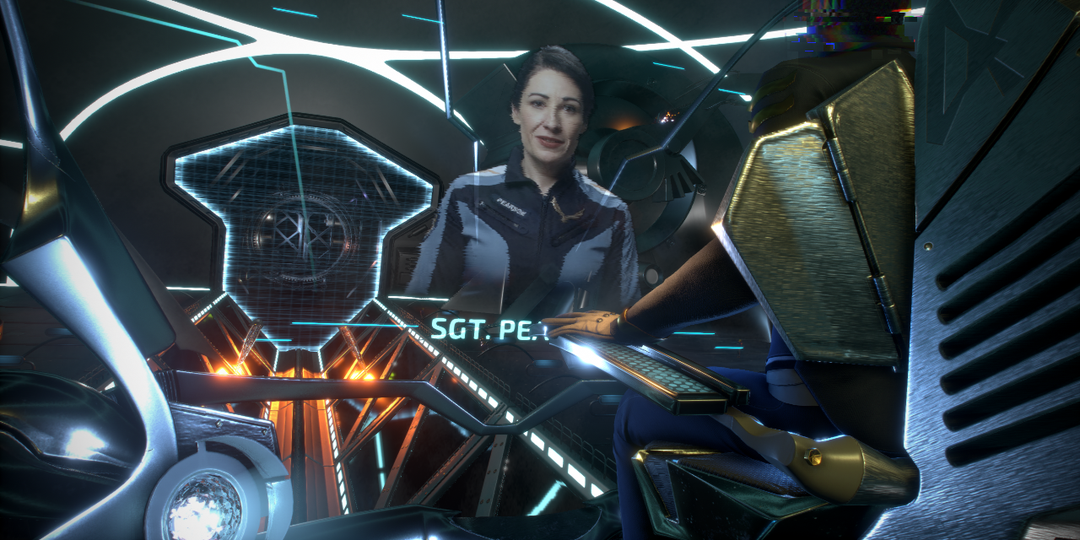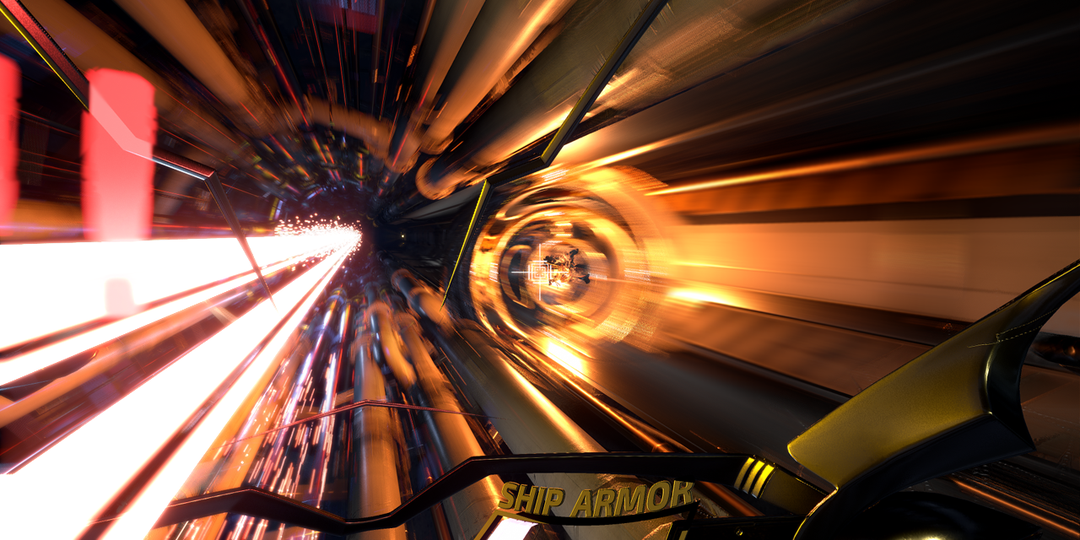Every now and then at PAX East, you see something that makes you stop in your tracks and do a double take. Wandering on the show floor past rows of platformers and shooters, each novel in their own way, beckoning you to sit for just a few moments so they can have a chance to impress, you continue on until that something special catches your eye. You stop. Slowly your mind catches up to what your vision takes in. There are no controllers. Just VR headsets with microphones. The screens show a first person view of the player sitting in what appears to be a ship's bridge chair overlooking a starscape as a woman officer talks over a holo vid screen.
You look up at the booth's banner spelling out the game's name, Starship Commander Arcade, and the realization sinks in. Could this really be what you think it is?
Get In The Pilot's Seat
If your first impression was the same as mine, that this is a game in which you literally sit in the captain's chair and give orders, then you'd be correct. Starship Commander Arcade is a game which is played entirely with a VR headset and mic, where you converse with your wingwoman and give commands to your ship's AI, and you have the freedom to respond to dialogue however you choose. It's one part interactive movie and one part virtual role-playing game. Let me tell you, that adds up to one hell of an experience.

Considering this game only has one other human featured, it has a lot of personality! Sgt. Pearson is pretty cool!
Let’s be clear about one thing here, though. This isn’t a review. My advice to you honestly on this matter is that if you should find yourself curious, in a VR arcade, and already paid through the hour, you should just try this game. You will not have played anything quite like this, and the experience is not to be missed. No, this article is about possibilities. This is about the future. It’s about both innovative game design as well as what VR could mean to the everyday gamer. It’s also about what gaming means to the non-gamer. It’s about what gaming means to those with disabilities. This is about an experience for everyone. And it’s about a type of game we should all be playing and yet have somehow never seen.
Anyone like me who grew on up episodes of Star Trek has probably had that fantasy; you know the one I’m talking about. Who hasn’t imagined themselves sitting in the captain’s chair? Maybe it’s testing yourself against the infamous Kobayashi Maru simulation, or maybe it’s just hailing another ship and attempting some good old fashioned diplomacy. Starship Commander Arcade puts you in that seat and does just that. It responds to your conversation while talking with your wingmate, Sgt. Pearson. The ship’s AI responds to your commands to lock weapons and engage the enemy. And your targeting reticule follows your line of sight allowing you to shoot down foes without any need for controllers. How on-point are the responses? According to Alexander Mejia, the Creative Director of Human Interact, the word error rate is less than 6% which puts it as more accurate than a professional typist; remember that dictation software has been a thing for years, after all, and I'll say that even with all the background noise of the Boston Convention Center the accuracy seemed pretty spot on. Combine that with a wide range of conversation responses and you have a recipe that actually feels more like you’re playing a tabletop RPG than a video game.
That, in fact, was the goal of the designers. They wanted to make something that wasn’t just “for gamers.” They wanted something that anyone could relate to, that even your luddite uncle could pick up and still not fumble between his thumbs. What you get is a roughly 20 minute, interactive mission in which you are the star of your own movie. I asked Alex why the shorter scenario length rather than a sweeping, hours-long narrative giving commands to multiple bridge stations; after all, if the tech was capable, why not give the gamers the grander experience we’d all be craving? His response was measured and thoughtful. Consider for a moment how many people you know that have a VR headset. Even if you personally own one, chances are you’re in the vast minority of gamers. Tack on the population at large, and while VR has been growing for the last few years, you begin seeing how it’s still very new, very expensive, and not very widespread in peoples’ homes yet. Where, you might ask, could the average person go to enjoy some nice VR games without spending hundreds of dollars? Why, at VR arcades, of course (it was news to me that such things were becoming more common, but maybe that’s what I get for living in the woods)! In designing a 20 minute mission rather than a 60 hour epic, Human Interact ensured their game was as widely available as possible.
Get VR in the hands of everyone. Check the demand. Make more chapters.

Giant lasers are best avoided!
The feedback they received in the initial demoing of this game said pretty much that; “get it out immediately,” and in making Starship Commander Arcade, that’s exactly what they did. Is this bite-sized story on rails? Unfortunately, at this time it is. Yet even knowing this going into the demo I played, I never felt like that held the game back. There are still so many ways I can respond to my wingmate. I can joke, I can lie about my age, I can ask her questions or play dumb in front of my ship’s AI before starting my run on the objective. In Alex’s own words, it’s like we’ve come full circle back to the days of text-based computer adventure games; even if you didn’t understand computers at that time, we all understood language. We could all type basic commands; our limit was really only our imagination. It’s a funny thought that people say things to Alex like “explain again how you play” and seem to struggle with the idea of simply talking to the game, doing what we do every day to one another. Bad experiences with Siri, he says, are probably to blame.
Of course, the game still makes sure you understand how to play. From a design perspective, it still gives you occasional on-screen graphical prompts disguised as ship readouts, ensuring that you don’t forget how to command your ship in the heat of key moments. And the main commands you memorize you’ll use over and over, so you feel clever giving the right orders even as practice makes perfect. Your conversations with the other pilot are open ended, and if I had one lament of my time with the game it was that I didn’t get to play more just to test other dialogue options. Overall, though, I could see how anyone could enjoy this game, whether a hardcore gamer, a non-gamer, or a person who can’t hold a normal controller. You need only the desire to sit in that chair and make the right calls.

A look into the possible future of games.
I look at a game like Starship Commander Arcade, and I see the future. Not in ships and space lasers, but in the experience that games offer us. Maybe some people are intimidated by controllers, but all of us have watched a TV show or movie. All of us communicate on a daily basis. All of us have had fantasies that put us in a performer-like role. Starship Commander makes this particular fantasy a reality. And in this modern world in which we live, where products like smartphones are sold as much on the experience they provide as their actual hardware, why shouldn’t games do the same? Story and characters sell video games (see Undertale and why dated graphics don’t matter). Alex has said that Human Interact is already considering new missions for future chapters, and I'm excited to see just how far this new style of game can go. So if you wind up in a VR arcade and see a Starship Commander mission in the menu, do yourself a favor and order it up. It's like nothing you've experienced, and I know this is one experience I'm going to be keeping a lookout for!